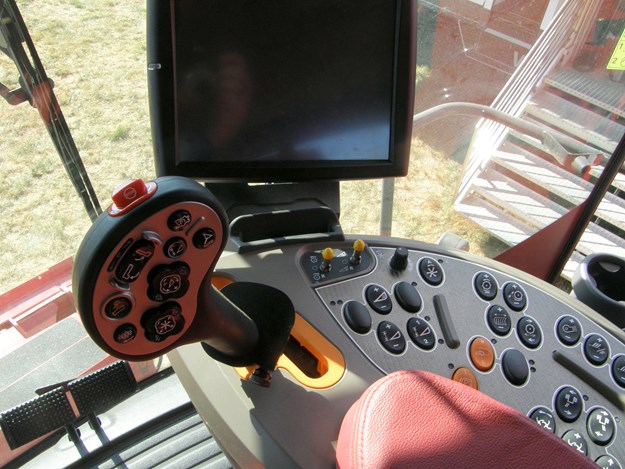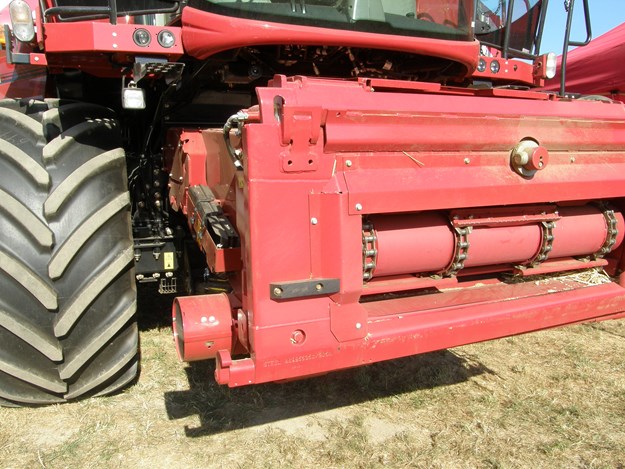European correspondent Chris McCullough travelled to Germany for the launch of Case IH’s new (and highly automated) Axial Flow 250 series combines scheduled for arrival on Australian shores in time for 2019 harvest
 |
Three new combines forming the Axial-Flow 250 series have just been launched by Case IH in a bid to maximise operator efficiency and crop quality.
The new models, 7250, 8250 and 9250, replace the Case IH 240 series and will go into production this October ready to be rolled out for the 2019 harvest.
There have been a number of new automated features added to the 250 series which the manufacturer says will allow operators to ensure they are operating the combine at maximum efficiency whilst ensuring grain quality is also the best it can be.
Replacing the 7240, 8240 and 9240 models in the older 240 series, the 250 series will focus on more automated changes to settings when tackling varying crop conditions during harvest.
Sam Acker, Case IH global product manager for flagship combines, says the new machines will be ready for most markets ahead of the 2019 season.
“Production of the Case IH Axial-Flow 250 series combines will start this October in time to have machines ready for the global 2019 harvest season.
“We will be rolling out the combines in each market in time for their own seasons. This means for Australia and New Zealand production will start in the fourth quarter.
“The US, Canadian and UK markets will also have the 250 Series machines ready for work next year,” he says.
August von Eckardstein, Case IH harvesting product marketing manager for Europe, Middle East and Africa, adds: “The 250 series Axial-Flow upgrades focus on improving both combine and operator productivity.
“Our aim has been to aid decision-making and make front-to-rear settings easier for a particular desired outcome. In this way, the combine can not only help to enhance an experienced operator’s performance, but can also help a less-experienced one to quickly gain confidence and get the most from the machine.”
 |
|
The full AFS Harvest Command automation package also features new in-cab pre-sieve adjustment
|
AFS HARVEST COMMAND AUTOMATION
One of the major changes for the new 250 series is the completely new technology in AFS Harvest Command automation which utilises 16 sensor inputs to continuously monitor the machine, and adjusts seven different settings to maximise combine performance.
Operators can manage this new technology through the in-cab AFS Pro700 terminal. The automation system is currently capable of working in wheat, oilseed rape/canola, corn/maize and soybeans. Just a few selections according to crop type and conditions allow the operator to set the machine to perform to a desired outcome.
There are a number of options on the AFS Harvest Command to suit the level of experience of the operator, the crop condition and type, as well as the harvesting conditions.
The basic version of AFS Harvest Command features the proven Automatic Crop Settings (ACS) system. This adjusts operating items such as fan speed and concave clearance according to the crop type selected on the AFS terminal screen, eliminating the need to make individual element settings. The operator is able to adjust the combine on the go and save the settings for future use.
The next version, with Feedrate Control, adjusts ground speed based on crop load to cater for a desired outcome, performance to control losses, maximum throughput, or fixed throughput.
The operator sets the target maximum engine load and ground speed, and Feedrate Control will operate up to those limits. The new Feedrate Control system more accurately controls ground speed based on crop and ground drive load. Feedrate Control, which can be used as a stand-alone function, works in all crop types.
The top specification option is full AFS Harvest Command automation, which automatically makes threshing and cleaning system adjustments based on the same desired outcomes as Feedrate Control, with the addition of grain quality monitoring.
This uses camera-based technology and sieve pressure sensing to provide further guidance to the machine’s automatic adjustment process to minimise impurities in the grain sample and maintain the best grain quality, a trait for which the Axial-Flow combine has earned its reputation.
August adds: “The AFS Harvest Command automation grain camera utilises a patented multi-spectral light emission, visible and invisible, to more accurately identify broken grains and impurities.
“This patented technology helps the grain camera more accurately monitor sample quality, illuminating it with UV, blue, green, red and infra-red light.
“Combining the five light spectrums provides enhanced detection of the exposed starch in broken grains. The AFS terminal alerts the operator if dirt affects camera clarity.”
With full automation, AFS Harvest Command can be used in four different ways. In all cases, the operator sets a maximum target engine load and maximum ground speed for the combine to then operate in:
• Performance mode: the combine operates at a speed to ensure an acceptable level of grain loss from the rotor and cleaning system.
• Fixed throughput mode: the combine maintains a target throughput by varying its speed, and adjusts settings to minimise losses.
• Maximum throughput mode: the combine operates up to the speed or power limit set by the operator, while adjusting settings to minimise grain loss from the rotor and the cleaning system.
• Grain quality mode: the combine adjusts settings to maintain a targeted grain quality and impurity level, while also minimising losses.
After selecting the ‘Basic’ tab on the AFS screen, the operator enters crop type, desired outcome/strategy, maximum ground speed and maximum engine load. The system is then engaged and harvesting begins.
Fine-tuning is possible via an Advanced tab that allows, for example, initial start-off settings to be altered, the frequency of automatic alterations to be adjusted, and ease of threshing to be accounted for.
“AFS Harvest Command automation is not designed to replace operator decisions, but to enhance them, identifying the factor limiting combine performance as conditions change, displaying it and making adjustments to address it,” says August.
“Experienced operators can further enhance output and grain quality, and inexperienced ones can more quickly achieve productivity comparable to an experienced operator.
“For both, AFS Harvest Command means less need to worry about factors such as losses, fan speed and rotor speed, which allows greater focus on header position and unloading.”
 |
|
A new 6.1-tonne lift capacity is available on the largest Axial-Flow models, to enable them to handle 13.5m draper heads and 18-row corn heads
|
ROTOR CAGE AND SIEVE UPGRADES
Axial-Flow 250 series combines with AFS Harvest Command automation are fitted with in-cab adjustable rotor cage vanes, actuated from a right-hand console switch when not using the automation facility, or automatically adjusting themselves when AFS Harvest Command automation is engaged.
The rear six vanes are linked, include a greater range of adjustment, and can also be manually adjusted from ground level. By changing the pitch of the vanes, the crop will move faster or slower through the rotor cage, tuning threshing and separation performance to crop conditions for improved efficiency.
In conjunction with upper and lower sieve control, the full AFS Harvest Command automation package also features new in-cab pre-sieve adjustment, allowing AFS Harvest Command automation to automatically adjust all sieve settings according to feedback from the loss sensors, grain camera and sieve pressure sensors. This can also be manually activated when AFS Harvest Command is not in use.
The in-cab adjustable pre-sieve is also available as a stand-alone option, which includes a remote switch allowing setting from the removable side covers.
Unique sieve pressure sensors provide AFS Harvest Command automation with sieve loading data, allowing the system to understand impending losses and make adjustments before they happen.
These sensors help the system discern the difference between sieve overload and blow-out losses, and adjust fan and sieve settings accordingly, preventing grain loss when exiting or entering the crop at the headland or stopping the combine in the field.
Working together with the Auto Fan option, this also helps prevent losses before they occur by detecting sieve load and combine inclination. The fan and sieves work in conjunction with each other to maintain an ideal operating setting and sieve pressure.
 |
|
A new hydrostatic transmission, featuring a field and a road mode and on-the-move two-speed range control, provides increased traction and means there’s no need to stop and shift while working or travelling on hills
|
TRANSMISSION CHANGES
A new hydrostatic transmission, featuring a field and a road mode and on-the-move two-speed range control, provides increased traction and means there is no need to stop and shift while working or travelling on hills.
Operated via a scalable multifunction handle speed controller, it features a closed-loop speed control which maintains the set speed in changing ground conditions. Maximum respective speeds in range one and range two are 18km/hr and 40km/hr, although reduced maximums can be set according to operator preference and field conditions.
Complemented by uprated hydraulic drives, the transmission upgrade boosts gradeability when road travelling by 36 per cent.
Meanwhile, a new differential lock upgrade replaces the previous mechanical pedal with a floor-mounted electrical button, and braking moves from an external disc to internal oil-cooled brake, reducing required pedal pressure for the same braking effort and enhancing the cooling required in situations where continuous braking is needed.
IMPROVEMENTS TO X-TRA CHOP PACKAGE
The X-tra Chop straw chopper package is now fitted with a new remote switch for ground-level spreader board actuation, to make accessing the engine deck easier for fuelling and maintenance.
FEEDER/INTAKE ELEVATOR UPGRADES
In addition to the existing feeder/intake elevator lift capacities of 4.5 tonnes and 5.2 tonnes, a new 6.1-tonne lift capacity is available on the largest Axial-Flow models, to enable them to handle 13.5m draper heads and 18-row corn heads. Factory-fit dual lateral tilt can now also help to provide enhanced control of 13.5m draper heads.
A new optional in-cab-controlled face plate fore-aft feature allows the operator to alter the header fore-aft angle, with a total of 11.9 degrees of angular tilt to improve harvesting efficiency in both low-growing crops like beans and high-growing crops. Header height control function upgrades mean improved responsiveness and flotation, plus adjustable return-to-cut and resume lower rates.
Ground Speed Adaptive Sensitivity (GSAS) automatically adjusts header height sensitivity as forward speeds increase and decrease, to keep the header stable yet responsive.
As an example, when sensitivity is set high for changing terrain and the operator slows combine forward speed, the system sensitivity will also drop in the background to keep the header stable. The sensitivity setting, though, will remain at the high set-point, so when the operator is able to return to the previous forward speed, the header remains responsive.


.jpg)